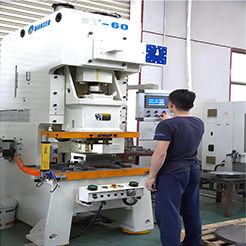
Spinning Operations in Precision Machining
Introduction: Unraveling the Precision in Spinning Operations
In the realm of precision machining, mastering spinning operation is akin to unlocking the secrets of intricate part production. This blog delves deep into the nuances of spinning, exploring its principles, techniques, and applications in the world of manufacturing.

I. The Foundation: Understanding Spinning Operations
1.1 Definition and Basics
Spinning, a form of metal forming, involves the rotation of a workpiece to achieve desired shapes. This method is particularly adept at creating cylindrical components with precise dimensions and intricate details.
1.2 The Mechanics at Play
The heart of spinning lies in the delicate dance between the spinning mandrel and the workpiece. The rotation of the mandrel imparts force and molds the workpiece into the desired form, relying on the principles of plastic deformation.
II. Tools of the Trade: Essential Components in Spinning Operations
2.1 The Spinning Lathe
At the core of spinning operation is the CNC metal spinning lathe, a specialized machine equipped with a spinning mandrel and a range of tooling options. The lathe’s precision and versatility make it a fundamental asset in the world of precision machining.
2.2 Materials Matter
Selecting the right material is paramount in spinning operation. Metals with excellent formability, such as aluminum and stainless steel, are often chosen. The material’s ability to withstand the deformation process without compromising structural integrity is crucial.
III. Techniques Unveiled: Mastering the Art of Spinning
3.1 Conventional Spinning
In conventional spinning, the workpiece undergoes plastic deformation, stretching and taking the shape of the mandrel. This process is ideal for producing seamless cylindrical components with a smooth surface finish.
3.2 Flow Forming
Taking precision up a notch, flow forming combines spinning and axial compressive forces. This technique enhances material properties, resulting in superior strength and improved dimensional accuracy, making it suitable for high-performance applications.
3.3 Shear Forming
Shear forming introduces a lateral force to the workpiece during spinning, creating complex shapes with intricate details. This technique is a testament to the versatility of spinning operations in achieving diverse geometries.
IV. The Art of Precision: Advantages of Spinning Operations
4.1 Cost-Effective Production
Spinning operations often lead to reduced material wastage, as the process involves forming without the need for extensive cutting. This cost-effective approach makes spinning an attractive choice for mass production.
4.2 Enhanced Material Properties
The controlled deformation inherent in spinning imparts favorable material characteristics. Components produced through spinning often exhibit improved mechanical properties, including increased strength and enhanced fatigue resistance.
5.1 Thin Wall Instabilities
Achieving precision in thin-walled components can pose a challenge. The inherent instability of thin materials may lead to deformities, requiring careful consideration of material selection and process parameters.
5.2 Tooling Wear
The repetitive nature of spinning operation can contribute to tooling wear. Regular maintenance and the use of durable tool materials are essential to mitigate wear-related challenges and ensure consistent quality.
VI. Pushing Boundaries: Advanced Applications of Spinning Operation
6.1 Aerospace Components
In the aerospace industry, where lightweight yet robust components are critical, spinning operations find extensive use. From forming fuselage sections to crafting intricate engine parts, the precision of spinning is indispensable.
6.2 Medical Device Manufacturing
The medical field benefits from spinning operations in crafting intricate components for devices such as catheters and implantable devices. The ability to produce complex geometries with high precision is vital in this sector.
VII. Quality Assurance: Ensuring Excellence in Spinning Operations
7.1 Process Monitoring
Implementing robust process monitoring systems is essential for maintaining consistent quality in spinning operations. Real-time feedback on parameters such as rotation speed, feed rates, and material temperature ensures adherence to specifications.
7.2 Inspection and Testing
Thorough inspection and testing protocols are vital in the post-spinning phase. Non-destructive testing methods, such as ultrasonic testing and visual inspection, play a crucial role in identifying defects and ensuring the integrity of the final product.
VIII. Future Horizons: Innovations in Spinning Technology
8.1 Smart Spinning Machines
The integration of smart technologies, including IoT sensors and data analytics, is poised to revolutionize spinning operation. Real-time data analysis will enable predictive maintenance, optimizing efficiency and minimizing downtime.
8.2 3D Spinning
The evolution towards three-dimensional spinning opens new possibilities for intricate geometries. This advancement expands the scope of spinning operation, allowing for the production of components with complex internal structures.
Conclusion: Unraveling the Potential of Spinning Operations
In the intricate tapestry of precision machining, metal spinning operations emerge as a thread of unparalleled significance.
From conventional techniques to cutting-edge innovations, the world of spinning continues to evolve, shaping the future of manufacturing with its precision and versatility.
As we navigate the complexities of materials, metal spinning techniques, and applications, the mastery of spinning operation becomes not just a skill but an art form in the hands of the adept machinist.
Spinning Operations in Precision Machining

Hot Metal Spinning Process

Punching machine processing service

Centrifugal fan impeller internal welding robot

Lampshade metal polishing process

